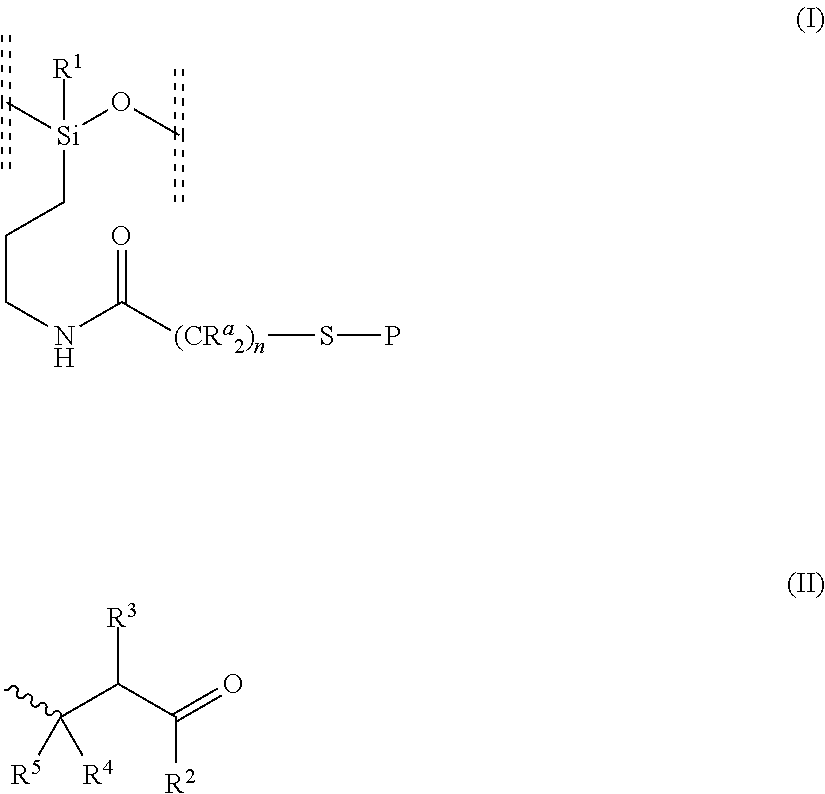Polysiloxanes as fragrance delivery systems in fine perfumery
a technology of polysiloxane and perfumery, which is applied in the field of polysiloxane conjugates, can solve the problem of relatively modest performance of polymers
- Summary
- Abstract
- Description
- Claims
- Application Information
AI Technical Summary
Benefits of technology
Problems solved by technology
Method used
Image
Examples
example 1
[0129]Preparation of Polymers According to the Invention
[0130]1) General Protocol for the Preparation of the Invention's Copolymers Releasing δ-Damascone
(a) Random α-ethoxy-ω-ethyl-poly{(methyl(3-(2-((4-oxo-4-(2,6,6-trimethylcyclohex-3-en-1-yl)butan-2-yl)thio)acetamido)propyl)siloxane-co-(3-aminopropyl)methylsiloxane-co-dimethylsiloxane}
1. Preparation of random α-ethoxy-ω-ethyl-poly(dimethylsiloxane-co-(3-aminopropyl)methylsiloxane)
[0131]In a 50 mL round-bottomed flask, 3-aminopropyl(diethoxy)methylsilane (9.87 g, 50 mmol), diethoxydimethylsilane (1.535 g, 10 mmol) and water (1.799 g, 100 mmol) were dissolved in the presence of NaOH (0.05 g 1.25 mmol) to give a colorless solution. The reaction mixture was stirred at room temperature for 4 hours. A biphasic mixture was obtained. Ethanol and water were removed by evaporation under vacuum to give an oil. FT-IR: 790(34); 1005 (30); 1176(84); 1257 (57); 1409 (87); 1591 (86); 2923 (80) Hansen solubility parameter: 14.85 MPa0.5
2. Preparat...
example 2
[0195]Evaluation of the Release of a Perfuming Ingredient from the Invention's Copolymers Incorporated into a Consumer Product (Fine Perfumery)
[0196]The invention's polymer (as obtained in Example 1.1).(b).2) (164.2 mg) was dissolved (upon heating) in ethanol (9 mL), then water (1 mL) was added. The sample (0.035 mL, corresponding to a maximum amount of delta-damascone of 9.1×10−4 mmol to be released) was pipetted onto a glass plate, placed inside a headspace sampling cell (ca. 625 mL) and exposed to a constant air flow of ca. 200 mL / min. The air was filtered through active charcoal and aspirated through a saturated solution of NaCl (to ensure a constant humidity of the air of ca. 75%). During 135 min the headspace system was left equilibrating, and then the volatiles were adsorbed during 15 minutes on a clean Tenax® cartridge. The cartridges with the volatiles were thermally desorbed on a Perkin Elmer TurboMatrix ATD desorber coupled to an Agilent Technologies 7890A GC System equip...
example 3
[0198]Evaluation of the Release of a Perfuming Ingredient from the Invention's Copolymers Incorporated into a Consumer Product (Fine Perfumery)
[0199]The following compositions were prepared according to the table herein below. The amount of damascenone chosen for the reference corresponded to the amount of damascenone comprised in 1% of the invention's copolymer (as obtained in Example 1 2).(a).2 and 2).(c)). The rest in the reference solution (Eau de toilette, EdT) was completed with a solvent (triethyl citrate) to keep the same amount of water and ethanol. Triethyl citrate was considered to have no impact on evaporation and odor intensity and was considered as being neutral.
Composition AComposition BReferenceComponent(weight %)(weight %)(weight %)Polymer of Example 11002).(a).2Polymer of Example 10102).(c)Ethanol 96%88.588.588.5Damascenone000.25Triethyl citrate000.75Demineralized water10.510.510.5
[0200]Composition A and composition B were then evaluated on a blind test in a sequen...
PUM
| Property | Measurement | Unit |
|---|---|---|
| Mw | aaaaa | aaaaa |
| Mw | aaaaa | aaaaa |
| Hansen solubility parameter | aaaaa | aaaaa |
Abstract
Description
Claims
Application Information
 Login to View More
Login to View More - R&D
- Intellectual Property
- Life Sciences
- Materials
- Tech Scout
- Unparalleled Data Quality
- Higher Quality Content
- 60% Fewer Hallucinations
Browse by: Latest US Patents, China's latest patents, Technical Efficacy Thesaurus, Application Domain, Technology Topic, Popular Technical Reports.
© 2025 PatSnap. All rights reserved.Legal|Privacy policy|Modern Slavery Act Transparency Statement|Sitemap|About US| Contact US: help@patsnap.com



